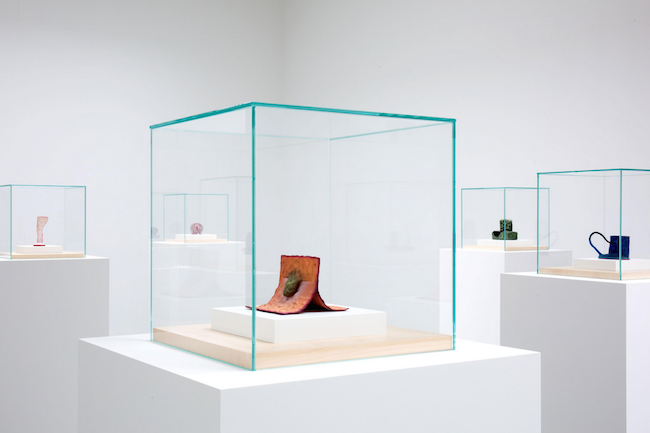We ran an extensive preview of Ron Nagle’s exceptional Five O’ Clock Shadow exhibition at Matthew Marks Gallery (New York City, September 11 – October. 24, 2015).
New York Times art critic Roberta Smith recently weighed in with her own opinions regarding the exhibition. We’re running pieces of that review here with some exceptional installation photographs.
From The Times:
Not surprisingly “Ron Nagle: Five O’Clock Shadow” seems to be knocking off socks right and left. Half of the show’s nearly two dozen pieces radiate from individual vitrines; the remainder combust in Tiffany-window-style wall niches, finished with blond wood.

Installation view of Ron Nagle, Handsome Drifter, 2015; ceramic, glaze, catalyzed polyurethane, epoxy resin; 3 3/4 x 4 x 3 inches. Click to see a larger image.
Never more than a few inches high, these pieces fill, figuratively speaking, three large spaces. Most are recent or finished this year, showing Mr. Nagle in top form. A few earlier ones remind us that this is only the tip of a very large iceberg that has yet to be examined in full. Four dark bronze vessels from 1991 allude to Mr. Nagle’s obsession with the teacup, whose elements — bowl, volume, handle — he kept in abstract rotation for years. (You can see a vestige of a teacup handle in the whiplash strand of “New Blue LaRue,” from 2008, which morphs into a central protagonist in several more recent works here.)
…

Mr. Nagle’s pieces have qualities that you feel — sometimes in the back of your throat — as much as see. The multiple associations include Japanese culture (sushi, netsuke, gardens, lacquer); weirdly upholstered daybeds; spindly succulents and vegetables; limbs or tentacles. Shining, oozing drips, depending upon color, conjure blood, chocolate or motor oil, as well as glaze run amok. Upright shapes referred to as wafers have rippling surfaces more akin to Carr’s water crackers, and theyintimate gravestones and sometimes even Neolithic hand axes.

Ron Nagle, “Ryder’s Sky,” 2015, ceramic sculpture. Photograph by Agaton Strom for The New York Times.
This tension is especially evident in “Ryder’s Sky,” a homage to Albert Pinkham Ryder, an American painter who also treasured smallness. A maroon-brown wafer shape dusted with white evokes nocturnal clouds from one end of a futon-like form. A great ooze of brown emanating from the wafer’s base heads toward a green mound — wasabi with a twist — that suggests a distorted Buddha or perhaps an actor in a kimono about to sweep offstage. The arrangement seems contemplative, perfect and hilarious, but maybe tragic. The compressed size and emotional intensity greet your eyes with the intimacy of a letter. You don’t know if someone is being driven away or implored to stay, and you’re not supposed to.
Love contemporary ceramic art + design? Let us know in the comments.






Add your valued opinion to this post.